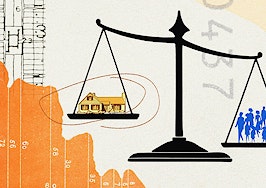- A market mismatch is the discrepancy between the amount of inventory within a specific price bracket and the demand for that type of inventory by homebuyers.
- The national market mismatch rate was 10.4 percent in a six-month period in 2016 that ended in September.
- Houston and Dallas had the two highest mismatch scores, at 31.2 percent and 30.3 percent, respectively.
In certain pockets of the housing market, demand for specific price ranges are causing a disconnect in available inventory and prices, according to a new report.
Trulia’s MarketMatch report shows 10.4 percent of home searches at a certain price point don’t match that specific category’s available inventory — though some markets are seeing as much as three times that rate.
While a market typically fluctuates based on the demand for a certain neighborhood, property type or price tag, this recent Trulia report takes a look at the changes based on search-specific budgets and tastes.
In some cases, homes are appropriately priced but not in a desirable price range, or buyers are seeking homes in a price range in which not many properties are available.
Looking at the national rate and in the 100 largest U.S. metros from March 15 to September 15, the national market mismatch was 10.4 percent, which is higher than the 8.3 percent market mismatch during the six-month period in 2015.
Nationally, 53.4 percent of properties viewed were priced below the median list price, which was a slight uptick from 51 percent during the same six-month period in 2015.
The two metros with the biggest discrepancies are located in the Lone Star State, the report shows. Houston ranked no. 1, at 31.2 percent, while second place Dallas had a market mismatch of 30.3 percent.
Year-over-year, Miami saw the biggest increase in market mismatch, going from 8.6 percent in 2015 to 21.2 percent this year. Colorado Springs had the largest dip, from 28.6 percent in 2015 to 16.1 percent in 2016.
The report shows 68.8 percent of search visits in Miami were below the median list price in 2016, an increase from 60.9 percent the previous year.
In Chicago, the market mismatch was 15.6 percent, up significantly from 3.7 percent the year prior. In 2016, 59.8 percent of visits were to homes below the median list price, up from 53.8 percent in 2015.
The Big Apple had a market mismatch of 11.9 percent in the most recent study, an 8.5 percent increase over the 3.4 percent reported in 2015. In 2016, 56 percent of visits were below the median list price home, a 6 percent increase over the previous year.
Los Angeles saw a 5.7 annual increase in its market mismatch this year, reaching 14.3 percent — up from 8.6 percent the previous year. Visits to listings below the median list price was 53.3 percent in L.A. during the time studied, rising from 44.4 percent in 2015.
Increasing 3.4 percent annually in San Francisco, the market mismatch was 10.7 percent in 2016. Of all home searches, 62.5 percent of them were below the median list price, an uptick from 58.4 percent reported the previous year.
Washington D.C. saw an upward trend of 3.8 percent to a market mismatch of 11.3 percent in the six-month period studied in 2016.














